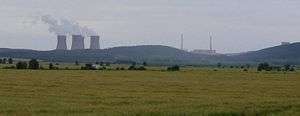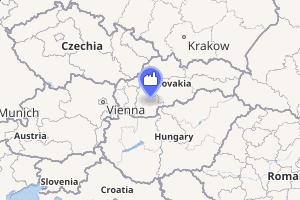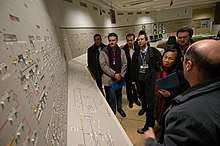Mochovce Nuclear Power Plant
The Mochovce Nuclear Power Plant (Slovak: Atómové elektrárne Mochovce, abbr. EMO) is a nuclear power plant located between the towns of Nitra and Levice, on the site of the former village of Mochovce, Slovakia. Two up-rated 470 MW (originally 440 MW) reactors are presently in operation, with two further reactors of the same type under construction. Generating almost 7,000 GWh of electricity a year, the power plant currently serves approximately 20% of Slovakia's electricity needs.[1]
| Mochovce Nuclear Power Plant | |
|---|---|
 Mochovce Nuclear Power Plant from the main road between Nitra and Levice | |

| |
| Country | Slovakia |
| Coordinates | 48°15′50″N 18°27′25″E |
| Status | Operational |
| Construction began | October 1, 1983 |
| Commission date | October 29, 1998 |
| Owner(s) | Slovenské elektrárne a.s. |
| Operator(s) | Electrostation Mochovce |
| Power generation | |
| Units operational | 2 x 470 MW |
| Units under const. | 2 x 471 MW |
| Nameplate capacity | 940 MW (gross) |
| Capacity factor | 84.1% |
| Annual net output | 6,922 GW·h |
| External links | |
| Commons | Related media on Commons |
History
A power plant consisting of four VVER 440/V-213 pressurized water reactors was proposed in the 1970s. The Czechoslovak government began with a geological survey to find a suitable seismically stable site. After taking into account all factors the location of the village of Mochovce was chosen. Preparatory work was started on June 1981, and site construction for Mochovce-1 and Mochovce-2 started in November 1982.
Construction of the remaining two units, Mochovce-3 and Mochovce-4, began in 1985 but work on all four units was halted in 1991 due to a lack of funds. In 1995 the Slovak government approved a plan to finish the first pair with additional Western safety technology. The first two units were commissioned in 1998 and 1999 respectively. Commissioning of the plant has sparked protests in Austria, a neighboring country strongly opposed to the use of nuclear energy in general. Installed capacity of units 1 and 2 was up-rated by 7% in 2008.
Construction of Units 3 and 4 restarted in November 2008. They were planned initially to be completed in 2012 and 2013,[2] but the completion date was shifted to 2016 and 2017.[3] More recently the completion date has slipped to 2020 and 2022.[4]
The owner of the plant is Slovenské elektrárne, which is 34% state-owned. Enel, an Italian utility company, was the majority 66% owners,[5] but sold half its stake to Czech energy group EPH in 2017. Enel plans to sell its remaining stake after completion of units 3&4.[4]
Units 1&2 operations


Since late 2008 the two operating units at Mochovce NPP have uprated net electrical power output to 436 MW per turbogenerator, ergo the total installed capacity of units 1 and 2 in Mochovce NPP stands at 872 MW. In 2009, the plant managed to generate over 7 TWh of electricity during a one-year period for the first time in its history. This represents approximately one quarter of the overall annual electricity consumption in Slovakia.[6] All units at Bohunice and Mochovce NPP feature evolutionary VVER pressurized water reactors, which are characteristic with:
- relatively low power and power density
- huge volume of water for cooling during normal operation as well as in emergency
- robust design with reinforced concrete containment with walls thick up to 1.5 m
- triple redundancy safety system (3 x 100%)
- high level of passive safety.[7]
The principle of electricity generation in nuclear power plants is similar to that of conventional thermal power plants. The only difference is the heat source. In thermal plants, heat is produced from fossil fuels (coal, gas), generating vast quantities of greenhouse gas, whereas in nuclear power plants, nuclear fuel is used (natural or enriched uranium). In the pressurized water reactors, fuel in the form of fuel assemblies is placed in reactor pressure vessel to which chemically treated water flows. The water flows through channels in the fuel assemblies and removes the heat that is produced during fission reaction. Water coming from the reactor has a temperature of about 297 °C (VVER reactor type); it is then led through the hot arm of the primary piping into heat exchanger - steam generator. In steam generator, water flows through a bunch of pipes and delivers the heat to water from secondary circuit and has a temperature of 222 °C. When cooled down, primary circuit water is led back to reactor core. Secondary circuit water is evaporated in steam generator and the steam is led via steam collector to the blades of a turbine. The turbine shaft turns a generator that generates electric energy. Having delivered its energy to the turbine, steam condensates in condenser, and getting back to water state, it flows back, via heaters, to steam generator. In condenser, the mixture is cooled by a third cooling circuit. In this latter circuit, water is cooled by air flowing from the bottom to the upper part of the cooling tower due to so-called chimney effect. The stream of air takes along water steam and small water droplets, and that is why clouds of steam form above the cooling towers.[7]
Units 3&4 construction
Units 3&4 of Mochovce NPP are currently under construction. This project is:
- one of the three projects of nuclear power plants currently under construction in the EU
- the largest private investment in the history of Slovakia
- 2/3 of works on site is performed by Slovak companies
- 90% of the population around power plant is in favour of the completion of Units 3&4
- each unit will have 471 MW electrical output
- annual production of two units will save over 7 million tonnes of CO2 emissions.[8]
Unit 3 was expected to be operational by the end of 2018 and unit 4 by the end of 2019.[4]
Safety
Although the original power plant design featured safety improvements such as seismically resistant attachment of equipment, it did not suit the safety and regulatory environment of the 1990s. To rectify this the German company Siemens supplied a new control system, and Western and EU safety measures were implemented during the final phases of construction. According to the plant operator Mochovce nuclear power plant was the first Soviet-sourced nuclear plant in the former Eastern Bloc to meet the safety standards of Western nuclear power plants.[9] The nuclear industry was conceived and developed with a conscientious awareness of having to face and respect strict safety guidelines, as well as technical, environmental and health standards. For this reason, safety at a power plant is verified and controlled at maximum possible levels in all of its phases (project design, authorization, construction, operation, decommissioning and final dismantlement), using procedures that have been elaborated exclusively for the needs of this specific sector. In addition, the realization of a nuclear power station is subordinated by a particularly complex authorization process comprising two different components: authorization from a nuclear safety standpoint, and in terms of its environmental impact (EIA – Environmental Impact Assessment). In concrete terms, safety in the electronuclear industry is entrusted to a set of technical, organizational and human measures enacted throughout all stages of an installation's lifetime, with the aim of protecting citizens and the surrounding environment from a release of radioactive material under any circumstances.[10]
Environment
Nuclear power plants emit no greenhouse gas to the atmosphere, in this way NPPs annually contribute to CO2 emission reduction by 15 million tonnes in Slovakia. Nuclear power plants hence contribute significantly to the obligation to reduce emissions of harmful greenhouse gas to the atmosphere. Mochovce NPP meets all international requirements and that the operation impact is minimal. Water required for cooling is taken from a water dam built on the nearby Hron river, which ensures sufficient supply of water even in extremely dry climate conditions. The impact of the discharged waters on the quality of the Hron river water, fauna and flora is negligible. Emissions to the atmosphere and effluents to the hydrosphere are regularly measured and assessed in the 15-km area around the plant. There are 25 monitoring stations of the tele-dosimetry system, which continuously monitor the dose rate of gamma radiation, activity of aerosols and radioactive iodine in the air, soil, water and food chain (feed, milk, agricultural products). The volume of radioactive substances contained in liquid and gaseous discharges is considerably lower than the limits set out by authorities.[6]
Radiation protection
For radiation protection of the power plant staff and population, the ALARA principle is applied. This principle ensures that the radiation exposure inside and outside the power plant is As Low As Reasonably Achievable and well below the limits set by legislation. The impact of the NPP operation on the environment and human health is negligible with respect to other radiation sources present in everyday life. There are 24 monitoring stations of the tele-dosimetry system in the 20 km radius around the power plant, which continuously monitors the dose rate of gamma radiation, volume activity of aerosols and radioactive iodine in the air, soil, water and food chain (feed, milk, agricultural produces). The volume of radioactive substances contained in liquid and gaseous discharges is considerably lower than the limits set out by authorities.[11]
Stress tests
Immediately after the Fukushima accident, European politicians, representatives of the nuclear industry and regulatory bodies agreed on the undertaking of power-plant safety reviews. All 15 member states of the EU operating nuclear power plants were involved. The testing of the two Bohunice NPP V2 units and all four Mochovce NPP units was carried out mainly through engineering analyses, calculations and reports. Stress tests analysed extraordinary external events – earthquakes, floods, and impacts of other events that might result in the multiple loss of power-plant safety functions. The combination of events, including loss of power supply, long-term water supply breakdown, as well as loss of power supply due to extreme climate conditions were also assessed. Stress tests revealed no deficiencies requiring immediate action; the further safe operation of neither the operating units nor the units under construction was put in doubt. Identified measures would further increase nuclear safety, for example by adding mobile diesel-generator for recharging of back-up batteries.[11]
Technical data
| Unit | Reactor type | Net el. power | Thermal power | Construction start | Commercial operation | Exp. shutdown (start) |
|---|---|---|---|---|---|---|
| Mochovce 1[12] | VVER 440/213 | 436 MW | 1471 MW | 1983-10-13 | 1998-10-29 | 2058 |
| Mochovce 2[13] | VVER 440/213 | 436 MW | 1471 MW | 1983-10-13 | 2000-04-11 | 2060 |
| Mochovce 3[14] | VVER 440/213 | 440 MW | 1375 MW | 1987-01-27 | under construction (2020) | |
| Mochovce 4[15] | VVER 440/213 | 440 MW | 1375 MW | 1987-01-27 | under construction (2022) |
References
- Slovenské elektrárne, a.s. - elektrina jej výroba a predaj
- "SE to complete Mochovce nuclear power plant". The Slovak Spectator. Archived from the original on 2007-03-01. Retrieved 2007-03-19.
- "Mochovce 3&4 costs rise to e4.6bn". Nuclear Engineering International. 24 November 2014. Retrieved 27 November 2014.
- "Cold testing completed at new Slovak reactor". World Nuclear News. 23 August 2018. Retrieved 24 August 2018.
- Mochovce nuclear new build programme kicks into action; 2008-12-28
- AE Mochovce. Slovenské elektráne, a.s.
- Nuclear power plants. Slovenské elektráne, a.s.
- http://www.seas.sk/mochovce-3-4-npp
- http://www.seas.sk/power-plants/nuclear-installations/atomove-elektrarne-mochovce-en/history-of-emo/ Archived 2007-03-15 at the Wayback Machine History of EMO on the Slovenské elektrárne webpage
- http://www.seas.sk/nuclear-safety
- Mochovce Nuclear Power Plant. Clear energy
- "MOCHOVCE-1". Power Reactor Information System (PRIS). IAEA. Retrieved 2020-01-13.
- "MOCHOVCE-2". Power Reactor Information System (PRIS). IAEA. Retrieved 2020-01-13.
- "MOCHOVCE-3". Power Reactor Information System (PRIS). IAEA. Retrieved 2020-01-13.
- "MOCHOVCE-4". Power Reactor Information System (PRIS). IAEA. Retrieved 2020-01-13.
External links
| Wikimedia Commons has media related to Mochovce Nuclear Power Plant. |